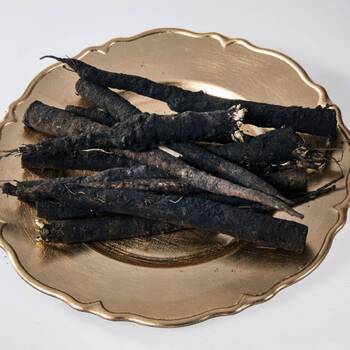
How to Grow Salsify Seeds
Grow Guide #2490
Family: Asteraceae
Binomial name: Tragopogon porrifolius
Life Cycle: Biennial
This 'How to Grow' guide details everything a home gardener needs to know to plant, grow and care for Salsify (Tragopogon porrifolius).
Salsify (Tragopogon porrifolius) and black salsify (Scorzonera hispanica) are different species botanically. This guide is relevant to both species as they are both grown in the same way.
When to Sow Salsify Seeds
Salsify can be grown year-round in most climates. Avoid planting in extremely hot or cold weather which can affect germination and growth. Use the table below to identify the best time of year to sow salsify in your climate.
| JAN | FEB | MAR | APR | MAY | JUN | JUL | AUG | SEP | OCT | NOV | DEC | |
|---|---|---|---|---|---|---|---|---|---|---|---|---|
| Cool | ||||||||||||
| Temperate | ||||||||||||
| Sub-Tropical | ||||||||||||
| Tropical | ||||||||||||
| Arid |
Preparation
Salsify plants are best grown in full sun. Choose a location that will receive at least 6 hours of full sun each day.
Salsify plants need a deep, loose, well drained soil enriched with organic matter. Prepare soil by weeding it thoroughly, digging it over to at least 40 to 50cm deep to loosen the soil, and adding aged animal manure or compost. Organic matter can be dug into heavy soil to lighten it so roots can grow freely. Keep the area free of weeds until planting.
How to Sow Salsify Seeds
Salsify seeds do not require any treatment (eg soaking, stratification) before sowing.
Salsify seeds grow best when they are sown directly into the garden.
- Sow seeds directly in the garden 6mm deep and 10cm apart, with rows 40cm apart.
- Keep soil moist but never wet or dry.
- Seeds should germinate in around 21-28 days at a soil temperature of 10-30°C.
- Young seedlings will need protection from pests, pets and weather until they are established.
How to Grow Salsify
Salsify plants may need watering during the growing season. Water when the soil is dry about 5cm below the surface (test this by scratching away a little soil with your finger). Water deeply in the early morning or late afternoon. Avoid watering the leaves of plants to avoid fungal diseases. Learn more about watering here.
Optional: To give plants room to grow, thin seedlings when they are large enough to handle. Pull out any weak or small seedlings so plants are spaced about 10cm apart.
Salsify plants will grow in nutrient-poor soils and do not need additional fertiliser during the growing season.
How to Harvest Salsify
Salsify should be ready to harvest in approximately 110-180 days.
Roots can be harvested when they are large enough to eat in their first year or when they are more mature in their second year, and can be harvested as needed. Harvest individual roots by gently pulling at the base of the leaves, or use a garden fork to lift multiple roots from the soil. Shake off any excess soil and cut the foliage 1-2cm above the top of the root. Store salsify short term in a perforated plastic bag in the fridge.
Common Problems when Growing Salsify
Like all plants, salsify is susceptible to some pests, diseases and other problems. Below is a list of the most common problems gardeners encounter when growing salsify plants:
 Aphids are small (2-4mm long) sap-sucking insects that congregate on the new shoots or the undersides of leaves. They can cause leaves to wilt or become discoloured, and also excrete honeydew which can attract ants and other insect pests. To manage aphids, remove them by spraying with a garden hose, apply a soap or alcohol spray, or encourage predatory insects to your garden. Read more about aphids here.
Aphids are small (2-4mm long) sap-sucking insects that congregate on the new shoots or the undersides of leaves. They can cause leaves to wilt or become discoloured, and also excrete honeydew which can attract ants and other insect pests. To manage aphids, remove them by spraying with a garden hose, apply a soap or alcohol spray, or encourage predatory insects to your garden. Read more about aphids here. Bolting is when a plant prematurely flowers and goes to seed. Bolting can be caused by a period of extreme weather. Avoid sowing seed until after the danger of frosts has passed or in very hot weather. Water plants regularly and deeply in hot weather to prevent them suffering heat stress.
Bolting is when a plant prematurely flowers and goes to seed. Bolting can be caused by a period of extreme weather. Avoid sowing seed until after the danger of frosts has passed or in very hot weather. Water plants regularly and deeply in hot weather to prevent them suffering heat stress. Forked roots are usually caused by stony or heavy soil such as clay. The roots cannot grow freely in the soil or hit rocks or other obstacles and split into two. Cultivate the soil well before planting, dig in some coarse sand or compost to lighten the soil, or grow round or short varieties suited to heavy soil.
Forked roots are usually caused by stony or heavy soil such as clay. The roots cannot grow freely in the soil or hit rocks or other obstacles and split into two. Cultivate the soil well before planting, dig in some coarse sand or compost to lighten the soil, or grow round or short varieties suited to heavy soil. Small roots can be the result of sowing too thickly or over fertilising. Thin seedlings to give roots adequate space to grow. Do not fertilise plants as this may encourage the growth of foliage at the expense of roots.
Small roots can be the result of sowing too thickly or over fertilising. Thin seedlings to give roots adequate space to grow. Do not fertilise plants as this may encourage the growth of foliage at the expense of roots. Split roots are usually caused by inconsistent watering when roots are mature. Water deeply and evenly to keep soil moisture consistent and always take recent or expected rainfall into consideration before watering.
Split roots are usually caused by inconsistent watering when roots are mature. Water deeply and evenly to keep soil moisture consistent and always take recent or expected rainfall into consideration before watering. Tough roots usually indicate that the roots were harvested too late. Harvest roots when they are young and tender.
Tough roots usually indicate that the roots were harvested too late. Harvest roots when they are young and tender.


.png)




